Buy one on GunsAmerica/Search.htm?T=Smith + Wesson + 647
Check it out at Smith & Wesson: Smith & Wesson 647 Varminter
I first laid eyes on this little/big gem while on a prairie dog hunt in the great state of Montana. It took just one shot at a distant prairie dog for me to know I had to get one in my hands. Big, heavy, long and beautiful, its performance on varmints was astounding.
The Smith & Wesson 647 Varminter is a product of the famous Smith & Wesson Performance Center. That’s where souped up guns, with lots of extra design features, and tender loving care come from. While you can discern the Performance Centers roots from the engraving on the side, this gun looks the part. Brushed stainless steel finish, shrouded and fluted barrel and beautiful wood stocks make its premium status pretty obvious.
[one_half]

The Smith & Wesson 647 Varminter with a Bushnell Elite handgun scope. Note the rear site has been removed to allow space for the optic.
[/one_half]
[one_half_last]
[/one_half_last]
In the box
This revolver arrives in pieces so to speak. You can think of it as a modular platform with a bunch of goodies inside the box that you can configure to your personal taste.
The revolver itself arrived naked. It had an adjustable rear site and the built-in rail, but nothing else mounted. The rear sight is a standard black notch design with windage and elevation adjustment screws. Included in the box is a front sight that clamps onto the exterior of the barrel, just forward of the fluting. This sight is a flat black, partridge style blade. The edges and corners are sharp, so you can get a crisp sight picture. If you want to go irons only, just pop this on and you’re ready to rock.
[one_half]
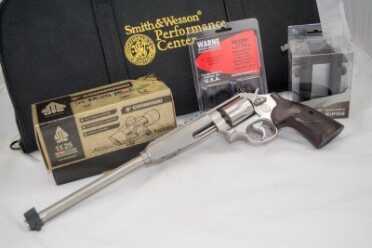
The Smith & Wesson 647 Varminter comes with a red dot optic, bipod, and stainless steel rail segment. I used the Warne scope mounts to try a Bushnell Elite 3500 handgun scope.
[/one_half]
[one_half_last]
[/one_half_last]
While we’re talking about sights, you’ll find a UTG 6” Commando red dot sight in the box too. This model comes with a Weaver / Picatinny mount that installs on the machined-in rail on the 647 Varminter. The optic offers adjustable red and green illumination and a sun shade up front.
You’ll find a stainless steel Picatinny rail segment that’s about 1 ¾ inches long. This screws onto the base of the barrel shroud just forward of the ejector rod. This is for the included UTG Shooters Bipod. This Bipod comes with a Picatinny rail clamp to mount directly to the Smith rail segment. The legs are about 4 ½ inches long with wide rubber feet for stability. The bipod legs lock into the up and down positions and release with a gnurled sliding knob. It’s an easy, quick, and positive locking action. The mount itself has a limited swivel movement, so once the legs are planted, you can traverse the revolver side to side. This traverse plate has a friction adjustment, so you can loosen the swivel action or lock it down according to your personal preference. The UTG Bipod comes with its original packaging, so there are extra goodies in there like a swivel stud mount. You won’t need this for the Smith & Wesson 647, so just know they’re there in case you want to use the bipod for other guns.
Also in the box are the obligatory extras including cable gun lock, owners manual, and fired cases. You’ll also find two keys for the internal lock present on most (or maybe all) of new Smith & Wesson revolvers. Because lawyers.
The Revolver
At first glance, you might think the 647 Varminter is a slightly scaled down version of the 460XVR, except the cylinder is a heck of a lot smaller. A barrel shroud with machined-in rail extends forward of the frame, then transitions to a long and elegant looking fluted barrel. On the 647 the shrouded section extends almost 4 ½ inches from the frame. The fluted barrel segment is an additional 7 inches, part of which is covered by a locking ring. Overall barrel length is 12 inches. With a satin stainless finish all around, this is one attractive revolver. You’ll notice a shallow beveled crown on the muzzle which helps protect from nicks and dings.
[one_half]
[/one_half]
[one_half_last]
[/one_half_last]
The shroud completely covers the ejector rod until you release the cylinder. One note here. There are about 1 ½ inches of clear space between the front of the ejector rod and the bipod mount which I found to be plenty of room to operate the ejector rod without interference.
The cylinder itself is fluted. As the .17 HMR is a rimmed cartridge, the chambers are inset into the cylinder, so cartridge bases line up flush when inserted. The ejector star is inset likewise.
Both hammer and trigger are chromed. The trigger has an adjustable over-travel screw, accessible with a small Allen wrench from the back side. When I received the gun, it was properly set with no detectable over-travel, but you can adjust according to your preference in seconds. While we’re talking about the trigger, I tested single-action pull weight at exactly 4.25 pounds. In single-action mode, there is hardly any movement prior to a crisp break, perhaps somewhere between 1/16 and 1/32 of an inch. The double-action trigger press exceeded my 10 pound Timney Trigger scale, but my educated guess is that it’s around 12 pounds. This is one of the few revolvers I would almost always shoot single-action anyway. I for one am not going to go all revolver purist and take precise long distance shots through a magnified optic using double-action. The hammer has aggressive checkering and has a positive feel, so cocking for single-action shots is easy and sure.
[one_half]
[/one_half]
[one_half_last]
[/one_half_last]
The stocks are two-piece wood. They are mounted using pins that lock them into position on the frame and an additional pin that secures them to each other. A single screw keeps them in place. Unlike other two-piece handgun stocks I’ve seen, these are incredibly secure. There is what I would describe as “soft” checkering on the sides of the stocks. This is appropriate as there is not enough recoil to make a super-sticky grip surface a necessity.
The Ammo
.17 HMR is a rimfire cartridge, but fortunately, it’s a lot easier to find than standard .22LR. It’s also more expensive, owing to its performance, bottleneck design and premium bullets.
[one_half]
[/one_half]
[one_half_last]
[/one_half_last]
Brought to market by Hornady back in 2002, this cartridge is derived from the .22 Magnum. The .22 WMR cartridge case is necked down to take a .17 caliber projectile. Large case capacity, combined with bullets in the 17 to 20 grain weight range, make for a smokin’ hot rimfire. .17 HMR can max out, in the right gun, around 2,500 feet per second. To put that in perspective, it’s about twice as fast as .22LR although the projectiles are about half the weight. It’s a flatter shooting, longer distance cartridge perfect for varmint hunting. I guess that’s why this gun is called the Smith & Wesson 647 Varminter.
For this review, I tested three varieties of .17 HMR ammunition.
Hornady V-Max 17 grain
Hornady XTP 20 grain
CCI FMJ 20 grain
We’ll get into specific performance of each through this revolver a bit later.
Optics
As we mentioned earlier, the 746 Varminter comes with a red dot optic. It’s fast, and perfectly appropriate for hunting, but this gun far exceeds the sighting capability of a 1x red dot. The very first thing I did was install a Bushnell Elite 3500 handgun scope. The Bushnell Elite 3500 is a 2-7x variable optic with duplex reticle. The outer area crosshairs are thick, while the inner crosshairs are fine to improve visibility and assist with precise aiming. Now we’re all set. The gun is capable of making a fire ant dance at 100 yards, so some magnification is in order, but that’s just my opinion. With the wide variety of potential uses for this revolver, I completely get why Smith & Wesson includes a general purpose red dot. If you buy a gun like this, you’re probably going to have very specific preference in optics. The included red dot lets you get started, then you can customize as you wish.
[one_half]
[/one_half]
[one_half_last]
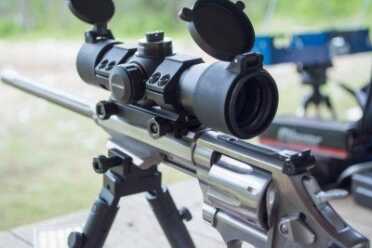
The iron sight is not in the way of the included red dot, but I had to remove it to mount a magnified scope.
[/one_half_last]
Shooting
Oooooh. That about sums up the shooting experience. This revolver is noticeably louder than a .22LR, but that’s expected given the significantly larger case and charge. Recoil is non-existent, also owing to the tiny, lightweight bullets coming out the fiery end. I started off shooting with the included red dot, but it immediately become clear that this is a 100 yard plinking gun. 25 yards is simply too easy. You can literally pick off aspirins all day long at that distance. The included red dot is fast and will get you going immediately after purchase, but I got spoiled and quickly mounted the Bushnell Elite 3500 magnified optic.
Shooting the iron sights with precision was surprisingly easy. Depending on exactly where you mount the front sight, you’re going to get about a 14-inch sight radius, which starts to approach rifle territory. This extra long sight picture, combined with the sharp flat black blades and notches, is easy to shoot, even for aging eyes. The front sight is about a mile and a half in front of your face.
[one_half]
[/one_half]
[one_half_last]
[/one_half_last]
This gun is not so heavy as to prevent a two-handed hold, but the bipod will spoil you. Rest it on a table, nearby log, or even the ground, and your ability to make precise shots magnifies ten-fold. The bipod is heavy duty enough that you can apply forward pressure against the legs to gain stability. I didn’t worry about bending or breaking anything.
The action was silky smooth right out of the box, as I would expect from a Performance Center gun. Even with the tiny, and sometimes finicky, .17 HMR cartridges, the ejector operated without fail. I have yet to get a cartridge rim stuck under the ejector star.
Cleanliness is next to Godliness
.17 HMR is a tiny cartridge. As a result, the cylinder holes are also tiny, as is the ejector star. In fact, all the internals are tiny. Tolerances are tight, so it’s extra important to make sure the 647 is clean. When everything is small, there’s just not much room for slop. Check the chambers to make sure there’s no gunk in there that will interfere with proper headspacing of the diminutive .17 HMR cartridge. Dirt can push the cartridge back a bit, causing friction with the breech face. If you feel any unusual tightness in rotation of the cylinder, check for debris under the ejector star. It’s a simple case of knowing your gun and keeping it clean.
[one_half]
[/one_half]
[one_half_last]
[/one_half_last]
Velocity
With the 12-inch revolver barrel, you won’t get the full velocity of 2,500 feet per second that you might obtain with a full length rifle. I tested velocity using a Shooting Chrony Beta Master Chronograph placed 15 feet down range and observed the following:
Hornady V-Max 17 grain: 2,096 feet per second
Hornady XTP 20 grain: 1,952 feet per second
CCI FMJ 20 grain: 1,987.5 feet per second
Bottom line? You’ll easily get about 2,000 feet per second with most, if not all, flavors of .17 HMR ammunition. That’s kinda smokin’ from a handgun, don’t ya think?
Accuracy
Hey, this revolver says performance center on the side so I decided to start my accuracy testing at 50 yards. 25 yards is for sissies. Since the target was 50 yards out, and my eyesight is rapidly stinking more and more, I used the configuration with the Bushnell Elite 3500 handgun scope, which offers 7x magnification. I shot 6-round groups, so every chamber was counted in the averages. From multiple groups, here are the average group sizes at 50 yards.
50 Yard Accuracy, Six shots
CCI FMJ 20 grain: 1.41 inches (Best 6-shot group was .78 inches!)
Hornady V-Max 17 grain: 3.7 inches
Hornady XTP 17 grain: 1.7 inches (Best 6-shot group was 1.41 inches)
When you look at that, you might think, “Oh, that’s nice.” Just remember, this was from 50 yards, using the bipod from a table, not a machine rest. The .78 inch group kinda blew me away, so I figured I’d move a target out to 100 yards. Yes, for a revolver.
[one_half]
[/one_half]
[one_half_last]
[/one_half_last]
100 Yard Accuracy, Six shots
CCI FMJ 20 grain: 2.94 inches
Hornady V-Max 17 grain: 5.92 inches
Hornady XTP 17 grain: 4.04 inches
Let me say that one more time. 100 yard accuracy testing for a rimfire revolver! Dang, this part was fun.[one_half]
[/one_half]
[one_half_last]
[/one_half_last]
Closing Thoughts
While this gun is clearly optimized for small game and varmint hunting, it sure makes a fun plinker. Take it to the range with a younger or newer shooter, and I guarantee they’ll be hooked. Using it from a table with the bipod makes the size and weight a moot point. The smallest (responsible aged) child can handle this gun with ease that way. Better yet, the inherent stability ill give them plenty of satisfaction with easy hits on target.
[one_half]
[/one_half]
[one_half_last]

Although I didn’t really need it, I used a bag of lead shot to stabilize the gun for accuracy testing.
[/one_half_last]
Lest you think this is a newbies gun, I think I appreciate it even more for plinking. There’s not much more fun than a good rimfire. The ammo for .17 HMR is generally premium stuff for hunting and varmint control, so you’ll pay more than for .22LR, but than than .22 Magnum on which this cartridge is based. One suggestion, if varminting, use any ammo you want. If you plan to hunt small game for the pot, consider using FMJ bullets as they’ll preserve a lot more meat. A V-Max projectile moving at 2,000 feet per second will certainly leave a mark!
Factory Specs
Model 647 .17 HMR Varminter
MSRP: $1,419.00 *
SKU:170229
Model: 647 – .17 HMR Varminter
Caliber: .17 HMR
Capacity: 6 Rounds
Action: Single/Double Action
Barrel Length: 12″ / 30.5 cm
Front Sight: Black Ramp
Rear Sight: Black Blade Adjustable
Overall Length: 17″ / 43.2 cm
Weight: 54 oz. / 1,530.9 g
Grip: Wood
Frame Material: Stainless Steel
Cylinder Material: Stainless Steel
Finish: Satin Stainless
Other Features: Red Dot/Green Dot Sight
Bi-Pod
Chrome Hammer
Chrome Trigger with Trigger Stop
Performance Center Tuned Action
[one_half]
[/one_half]
[one_half_last]

The iron sight is not in the way of the included red dot, but I had to remove it to mount a magnified scope.
[/one_half_last]

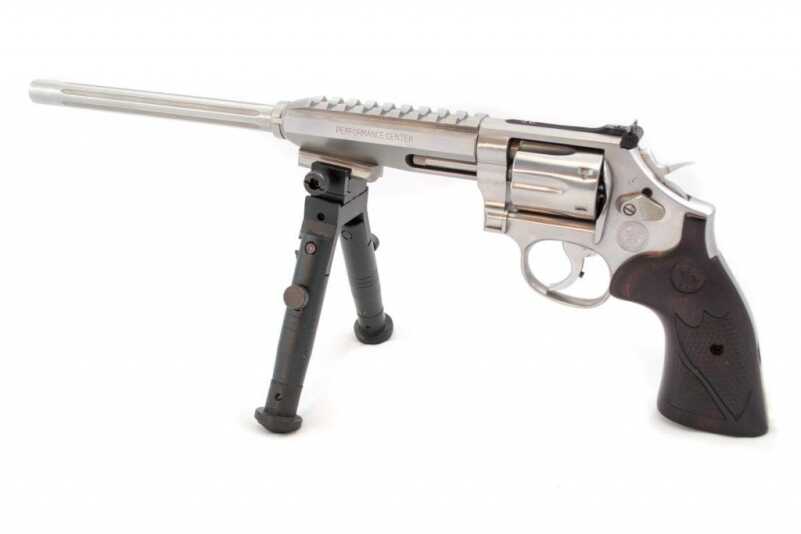
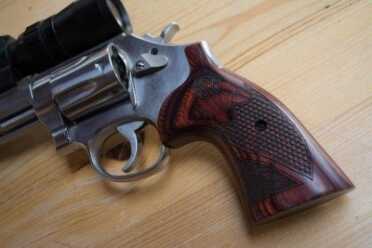
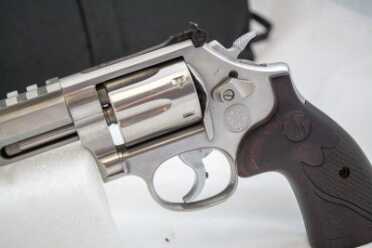
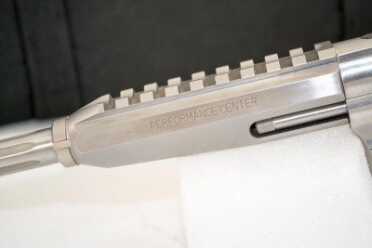
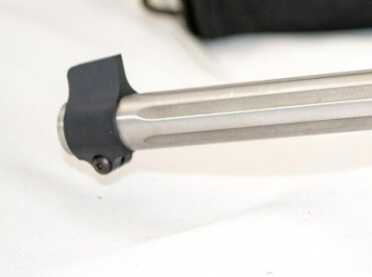
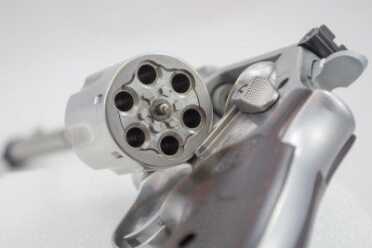
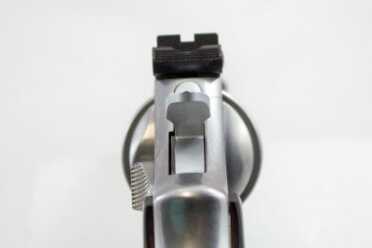
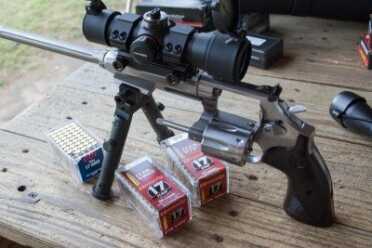
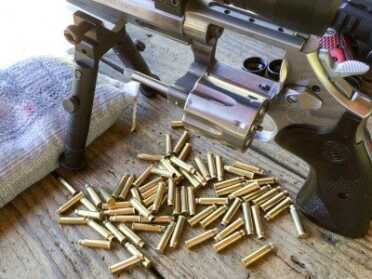
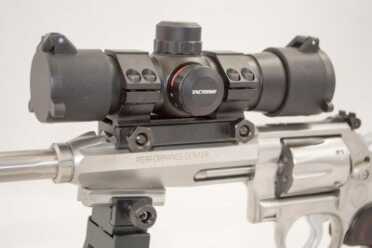
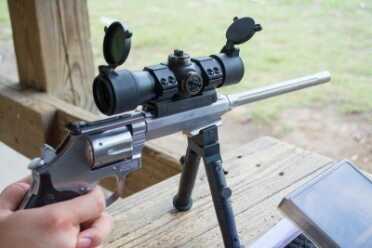
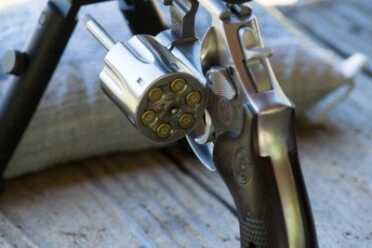
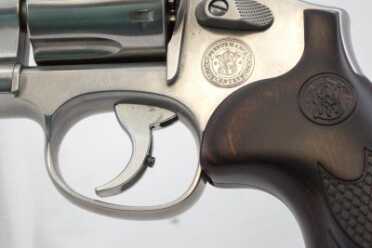
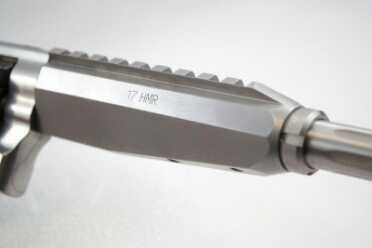
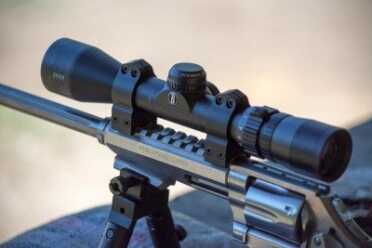


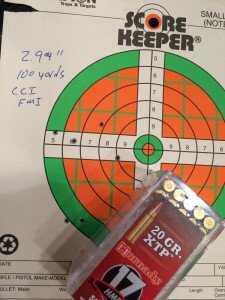
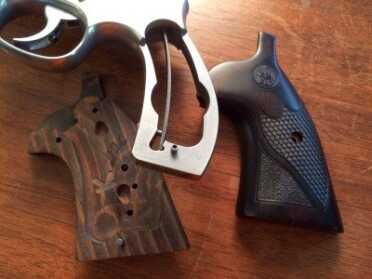
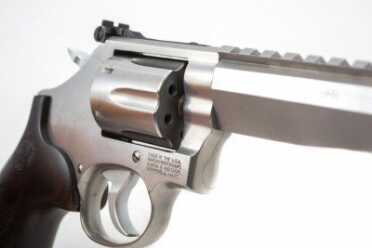
I wonder if they could make this in 17WSM?
Kinda good looking till I saw the sad looking groups at 50 and 100 yards. With the .17 you ought to be ashamed of yourself and with a scope and a bipod to boot! After I got thru laughing at the groups I saw the price and don’t think I’ll ever stop laughing! Give me a break, for that price this thing better do a whole helluva lot better than it did. Nope, waste of money in my opinion.
Say what you want, I want one!
Chromed hammer and trigger? S&W usually uses nickel plating for parts and complete handguns. That must be why it is so expensive.
As I read the comments, as numerous as they are, I found so many different points of view. “It’s too expensive!”. Well, in this ever changing world 1400 samolians really isn’t THAT expensive. I have a Kimber 1911 that I had to sell two of my children to promote the cash. (Even though I had a no buy-back contract, the buyers sneaked in and dropped them off in the middles of the night…..along with 6 kittens and a hamster). The only conclusions I came to were: 1. People have different priorities when dealing with firearms. 2. You can’t please all the people all the time, and (most importantly) 3. Everybody’s got a cure for the cold.
As for me, my favorite firearm out of several I own is a Remington 514 .22 that I traded $7.00 and a broken gas-powered model airplane for, to a neighbor kid 59 years ago. It’s hard to beat accuracy and reliability.
I wish for ALL of you a safe and happy holiday season.
Yep, I have a Kimber pro carry 1911 but it doesn’t shoot any better than my Rock Island compact 1911a. In other words just because it’s more expensive it doesn’t mean it’s better I found out first hand. $1400 is a lot of money to a working man to plunk down on a piece that’s not worth it.
I shot IHMSA for years with TC Contenders and Remington XP-100s-. Those handguns are capable of minute of angle accuracy. The accuracy of this S&W “varminter” is not poor, it is pitiful.
The gun does look pretty cool and I was waiting to see the caliber thinking it might be something new or maybe something like a 223 bullet in a pistol. I was a little disappointed to find out it was a 17 HMR. As some of the others indirectly stated a little bigger and heavier bullet might have brought a bit more interest and positive comments. Those of us who can only sneak a gun past our wives now and then may pass but I imagine some of the collectors and folks with a bigger wallet might bite. As to reloading, I suspect a 17 HMR could be reloaded if they would sell primed brass and other components for them but I can’t see it catching on that well.
I love S&W hand guns But this thing looks like some one jury rigged it in there garage. What an abortion. If S&W wants to build a revolver make it look like it was made by some one who knew what they are doing, and not thrown together from a bunch of parts they had laying around. And the price WELL that is another story.
What non-sense!! This is neither fish nor fowl, just a toy for people with more money than brains, or money at least. I have a heavy barrel .17HMR Savage rifle that will make .35″ all day off the bench with a 3-9x40mm scope. I’ve been reading these gun rags for 35 years, but I’m pretty sure this the goofiest thing I’ve ever seen. Nor is it particularly accurate. A Ransom rest would be a true test, as that takes all the human variables out of the process. I feel confident that carried at the ready, as a hunting firearm should be when engaged in the sport. it has to be a fairly awkward to deploy. I can sling up, or rest, faster that this critter can be put to work, I think. Interesting toy, but the ammo is too expensive to play with. I give it a 68 out of 100, and that’s because it is well finished. Shame is, it’s too small to be a decent boat anchor. Smith is gonna eat it on this mousetrosity. Why didn’t’;t they make something useful, like a wide body 1911 style 6″ heavy barrel in .40 Super? Nobody is, to my knowledge, and the .40 does put some power out–nearly .44mag. and with 10 rounds , no reason not to make a fatal hit on deer size game at 100+ yards. And fun to shoot, if you reload. Commercial gun magazines have an axe to grind–they need their advertiser’s money to keep running, and I have no doubt some writer’s take that too far. Even the American Rifleman is usually gentle in their commentaries. Gun Tests is the only magazine that is supported by purchasers, and they pull no punches. If it’s a dog it’s a dog. And it it’s truly top rate, they’ll say that too. And anything and everything in between. After all , they have no advertiser’s to lose, and more readers to gain, by being painfully blunt at times. Honesty goes a lot farther than flowery verbiage that essentially means “I wouldn’t let my worst enemy shoot this”. I confess to buying the Granddaddy of all, “Guns and Ammo”. They are generally reasonably fair, often have lead info you don’t see in other mags for weeks, and have excellent photography. Mea culpa. Lock and Load
Respectfully
dhconner.
I’ve seen friends use .17 HMR pistols on prairie dogs with great success. One uses a 12″ Anschutz and another uses a 14″ Thompson Contender. What they do is work a PD town located in a field with lots of sagebrush. We spend the morning shooting with full sized varmint rifles, but there are a lot of dogs scattered through the sagebrush that you can’t see at any distance due to the cover. So my buddies head out with their pistols and a lawn chair and take turns spotting and shooting out to about 125 yards. The lawn chair puts the shooter high enough up to see over the sagebrush for close range shots. The 17 HMR kills the prairie dogs dead at that range, but is quiet enough that the dogs stay up out of their holes. We call that a “lawnchair safari”.
Something like a .223 rifle will also work at that range, but the rest of the dogs dive into their holes at the sound of a high powered rifle shot that close. So in those conditions the the 17 HMR works very well. I picked up a TC Contender carbine with a 21″ barrel to take on my next PD hunt. It is very accurate, only weighs about 6 lbs with a scope and is quieter than the 12-14″ pistols.
I found the gun to be somewhat exciting (but that was dashed when I saw the price), but not nearly as the writer got when writing the article. He came across as knowing very little about S&W revolvers in general, using terms such as “extractor star”, it is an extractor, period. I own over 30 S&W revolvers and not one of them has ever had loose grips. The single pin on the frame has worked well for more than 80 years as keeping the grips in place. Pointing out that the grips have an extra pin on them is overkill, especially on low recoiling caliber handgun. Also 2000 fps on such a lite bullet, gives up a lot at ranges above 100 yards. By the way has he not heard of the .22 TCM, it shoots a bullet nearly 2 to 2.5 times it’s weight (40 grains versus 17 & 20) at 2100 fps. Accuracy is on par out to 100 yards on a 1911 platform, at several hundred dollars less. Come on S&W, you can come up with something more exciting. Lastly, of all the S&W revolvers I own, none have been made in the last 25 years, your money could be better spent on a couple used S&W revolvers.
OMG!!! A cardinal sin using the term “ejector star”!!!!! Forgive me for using a common descriptive term to help new(er) shooters know what I’m referring to. Same with noting that the grips are pinned for extra stability. Not everyone has your incredible knowledge and expertise, so we writers cater to regular humans too. Sheesh, lighten up.
My wife gifted me a Thompson Contender HMR.17cal. several years ago and except for the single shot vs. six aspect you could write the same article. Results have been very similar and I carry a Savage Varmiter Rifle of the same cal. and I use them both on the same hunts. 50-100 yard results in a lot of dead rodents either way. 6-24 variible on the rifle and a 3-8 on the TC. cheapist fun you can have. Also have a .22cal Anshutz that is almost as accurite at similar distances.
Obviously the writer of this review was being “compensated” to print sunshiney things about this creation. As a whole I don’t much trust Gun Writers. They are for the most part “for sale” to the highest bidder. Getting an honest review out of them about something they are being compensated to review is the exact definition of a conflict of interest. All that being said, if you’ve never fired a 17HMR on a windy day, (the wind never blows across varmint fields right?) before you plunk down any money on one you might want to borrow one from someone. The entire concept of this round is severely limited by the tiny projectile. Wind drift, even at short ranges is significant. As far as accuracy, the groups displayed are nothing to brag about. Any one of my .22LR rigs will easily put these to shame. At 50 yards, my Ruger MKII will shoot circles around this gun. If you are patient and persistent, .22LR is available out there. The .17HMR is Hornady’s answer to nearly nonexistent 22Mag sales. It’s a gimmick round and that’s all it will ever be. For Smith & Wesson to commit the resources toward R&D and production and then to slap a $1400.00 price tag on this package is perfect demonstration of just how far this Company has fallen from mainstream firearm theology. Someday the 647 will make a nice conversation piece about failed firearm platforms and it makes an interesting paperweight, but that’s all this pistol will ever be good for. This is a ridiculous waste of time & resource.
Obviously you should pull your head out of your behind. It’s ok for someone to like something without being paid off. Oh, or maybe not you I guess.
Dang. Busted. I got paid $17,450,912.53 by the Smith & Wesson folks to write this article. That’s how I’m so rich! Unfortunately, they paid me in Hungarian Pengos, so I’m not quite sure how to collect…
Now that the cat is out of the bag, and you’ve told everyone how we gun writers afford G6 jets, I guess I’ll have to find a new career. Does making ridiculous comments on the internet pay well?
Just does not impress me. Several Freedom arms revolvers in different calibers and one Don Wesson in .357 MAX used in IHMSA using my hand loads will put these groups to sham.
Just does not impress me. Several Freedom arms revolvers in different calibers and one Don Wesson in .357 MAX used in IHMSA using my hand loads will put these groups to sham.
I used to shoot IHMSA too. My old DW 357 Maximum would launch a gas checked 220 grain LBT WFN at 1500 fps, and would shoot 1.5″ groups at 100 yards all day long as long as you did your part.
3 to 6 inch groups at 100 yards for a “varminter”? That’s pretty poor. Was there something wrong with the gun tested? My Model 17 and T/C Contenders shoot much beter than that.
I was thinking the same thing, I became excited when I read the title of a long range revolver but this smith leaves me wanting more. For the money you can have Bayside Custom Gunworks build a true long range revolver in one of the Franken-Ruger conversions. Noted long range pistol shooter Ernie Bishop just pulled off a sub 4″ group at 500 yards with his Franken-Ruger 357 Mag. You can find the video on YouTube.
Meh…Yet another Saf-T-Hammer produced Smith & Wesson that I don’t want.
Soooo, it’s being recommended that a person spend more than $1,400 and order the handgun from a manufacturer’s custom shop, egh? I’ll do one better and for a whole lot less money… Look at the Crickett Chipmuck Hunter .22 magnum pistol.. Yep, you read correctly: “Crickett,” the same company that makes those ubiquitous kid-friendly single-shot .22-caliber rifles. Only the pistols are sleek and modern-day as all get out. Single shot, of course as well as being bolt-action. And though mine is chambered in .22 magnum they also are available in .22-caliber… They are fitted with 10.5 inch barrels and weigh 2.5 pounds… Though outfitted with adjustable iron sights a base mount is available for a few bucks. As for the Chipmunk Hunter, Bud’s Gun Shop has them for $196 with a really cool genuine laminated wood stock, or $236 if you want the pistol in genuine synthetic stock, complete with mounted 2×20 optics and a bipod and a hard case, to boot. Oh, did I forget to mention that the one I begged for last Christmas not only has this sweetest-looking laminated stock but the metal is also stainless steel? E-yep, it is… Now I can’t say that the Crickett with the laminated stock is a Bud’s Gun Shop exclusive (this outlet does seem to have the best selection) the Internet does show that private sellers are giving hem up for $120 (base model, synthetic stock) to more than $300 for a full rig. Gents, I’m here to tell you, this is one very nice shooting iron. Just ask the woodchuck the Crickett met last week. Oh, wait, that’s right. The woodchuck can’t talk. A single shot from the Crickett ensured that the woodchuck would never squeal to any of its kith and kin.
Back when I shot IHMSA, I had a S&W 617, with an 8 3/8″ barrel and silhouette sights. When I was doing accuracy testing, I put a scope on it, and off sandbags, using Fiocchi Match 22 ammo, I was rewarded with 1.75″ groups at 100 yards. I’m not talking 1.75″ as my best group with that ammo, that was the normal group. I didn’t sort for headspace, this was with ammo straight out of the box. That pistol was phenomenally accurate with loads it liked. S&W makes some accurate revolvers, for sure…. Too bad that there’s not more makes of 17 HMR ammo commercially available, or, even better, that components for handloading aren’t available, because I’d be willing to bet that with some proper load development work this revolver would group even better than what’s shown above.
And your going to reload a rim-fire how?
@Blasted Cap–perhaps it escaped your consideration that I might not be talking about reloading fired rimfire cases?
Handloading does not necessarily imply reloading a previously-fired case. In specific, I was talking about making primed/unfired rimfire cases, appropriate powders, 17 caliber bullets, reloading dies, and a shell holder available to those of us who want to try and tune the round to the gun and potentially improve accuracy compared to what is achievable from a particular gun with commercially loaded rounds.
A $1,400.00 plinker? Oh, yeah, I’m gonna run right out and buy one!!! Ridiculous……….. rich people and their absurd toys.
I absolutely agree. I’m tired of gun articles – and magazine ads – featuring hand and long guns (and ammo to match) that require the average Joe to take out a loan.
Are you kidding me,only a 6 shot capacity in that big cylinder ? H&R once came out with a 9 shot 22 revolver.Its not like this is a high pressure cartridge .I have no doubt about their accuracy claims or quality of this firearm . I’ve shot prairie dogs in MT,I was hard pressed to spot any under a 100 yards.
i believe the article refers to this gun as a 647.
It is widely held that the S&W Performance Center does great work. This is another fine example. I really enjoy pushing the commonly accepted range limits of firearms but after experimenting, they resume routine duties. The 642 is an exotic, purpose driven package. There are rifle platforms that will deliver better accuracy at a much lower price point, so it must be the handgun fun and challange factor that will appeal to buyers of the 642. As with all firearms, accuracy is also dependant on your ammo. Like all rimfire firearms, it is not a handloaded round (though I have seen a few people experiment with it) you can not tune your gun and ammo and just have to select the best grouping or terminal effect you can find. You can weigh and group them with a electronic scale and there may be bullet guages for them like they have for 22LR. This is the Achilles Heel of the rimfire, hope it doesn’t trip up the 642.